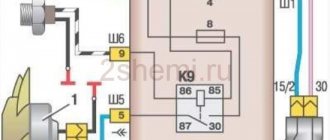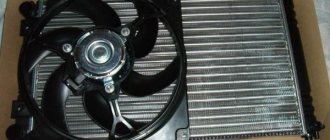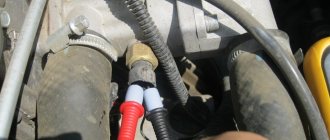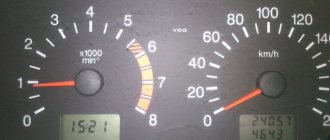The fan is designed to create an artificial air flow directed at the engine radiator in order to cool the liquid circulating in it. When the car is moving at high speed, there is, of course, no particular need for it, but at low speeds, and also when the car is idle with the engine running, you cannot do without it.
The radiator fan is turned on by a signal from the electronic control unit based on data received from the temperature sensor, which is triggered when the coolant heats up to 103-1050C. In a VAZ 2114 car, the fan is located in the engine compartment on the back side of the radiator.
What to do if the VAZ-2114 injector cooling fan does not work
It should be noted that if the car is moving at high speeds, there is, of course, no particular need for a working fan. But as soon as the speed of the car decreases, and also when the car is idling, you simply cannot do without a fan. This device turns on automatically as soon as it receives a signal from the electronic control unit. This signal is based on data received from a temperature sensor, which is triggered when the coolant temperature rises to 103 degrees.
Using an electromagnetic relay
Using a simple relay will slightly complicate the circuit, but will relieve the temperature sensor from the presence of high current. A large current will flow through the relay contacts. It is cheaper and easier to replace the relay than the temperature sensor to turn on the electric fan. To carry out the upgrade, you will need a wire and a relay with a bracket for mounting to the body.
Disconnect the temperature sensor, and the wires that were on it must be connected to the normally open pair of contacts of our relay. Half the job is done, the power part is ready. Now control. We connect one terminal of the temperature sensor to ground, but connect the second to the relay coil.
From the second terminal of the coil you need to stretch the wire to the positive terminal of the battery. It is advisable that the connection be made through a fuse, the operating current of which can be 1 Ampere. The coil consumes a small amount of current, so the worst thing that can happen is a short circuit in the wiring. Subsequently, you can connect a forced activation button in parallel with the temperature sensor, which you will install in the car interior.
Finding possible causes of fan malfunction
The search for possible reasons why the fan on the VAZ-2114 does not work must first begin with the fan itself.
To do this, disconnect the fan connector and connect it directly to the battery terminals, while maintaining the polarity. If the fan starts working, it means that it is fully operational and the reason lies in something else. But if the fan still does not turn on after the above manipulations, you should check the condition of the sensor contacts and whether the wiring is intact. If in this case everything turned out to be fine, it’s time to check the fan relay and fuse. Both of these parts are located under the hood of the car, closer to the driver's side in a special mounting block.
It should be noted that fuses 20A and F4, responsible for the fan and sound signal, are double on the VAZ-2114. Therefore, if the reason for the fan not working lies precisely in the fuse, then the sound signal will not work. You can check the functionality of the fuse using the most common automotive tester.
But, unfortunately, you will have to tinker with the relay.
In order to confirm or rule out the relay problem, you should acquire a similar device that has been tested for performance. You need to temporarily install it in place of the old one and check whether the fan starts working. If in this case a miracle did not happen, we move on to inspecting the sensor.
After de-energizing the sensor, the fan should start in emergency mode and provide constant airflow. To do this, disconnect the sensor from the connector and turn on the car ignition. If the fan finally starts working, this indicates a sensor malfunction. The latter, by the way, cannot be repaired, which means it can only be replaced.
How to perform a check on injection VAZ cars
It is quite possible that this can also be done on other cars, but I will not vouch for the result, since I tested it with personal experience only on domestic injection cars VAZ (2109-2115), Kalina, Priora, etc.
To quickly check whether your fan is working or not, just follow these steps:
- open the hood of your car
- turn on the ignition
- we find the coolant temperature sensor (most often it is located on the thermostat housing)
- disconnect the electrical connector from it
DTOZH VAZ
If the fan motor is working properly, it should turn on immediately when you remove the “terminal” from the sensor. If this does not happen, then the fan is faulty.
Yes, you can, of course, remove the connector directly from the fan itself and check everything using the battery power supply, but you must agree that this is a much more labor-intensive process than removing the connector from the temperature sensor.
When do you need to change the fan on a VAZ-2114
If the reason for the non-working fan lies in the fan itself, you can still try to repair this part.
As a rule, the problem lies in the bearings. But sometimes it also happens that due to a break in the windings or a short circuit, the fan motor itself fails. If this happens, then it is better not to try to repair anything, but to replace this part. By the way, driving a car with a non-working fan is strictly prohibited. As a result of this action, the coolant can warm up significantly, which will lead to complete destruction of the pipes and rubber hoses. Driving a short distance with the fan not working can also cause the cylinder head and valve cover gaskets to fail. But that's not all. Overheating of the engine can also destroy some elements of the piston group.
Simply put, a non-working fan (its cost, by the way, is not that high) can cause much more serious problems, the elimination of which will entail significant material costs. On average, the cost of a new fan for a VAZ-2114 varies from 1.5 to 2 thousand rubles. Replacing it at a service center will cost another 500 rubles. But replacing all the above parts and gaskets can cost more than tens of thousands.
Connection diagram for VO VAZ 2110
The circuit diagram for switching on the cooling fan of the VAZ 2110 on carburetor and injection cars is different. On cars with a carburetor engine, a thermobimetallic sensor TM-108 is used for this, and on cars with an injection engine, control is carried out by a controller.
The cooling fan does not turn on on the VAZ 2114
The engine cooling fan on the VAZ 2114 does not work. Tell me why the radiator fan stopped turning on? What is the reason and where to look?
Hello. Tell. I replaced the main radiator with a VAZ 2114, year 11, 8-valve. I filled it with antifreeze. Heated up the car. The fan didn't work. Changed the fuse. Sensor.
The fan does not work when it should. You turn off the car, then turn on the ignition and it works. What could it be?
The cooling fan does not turn on. What can you do?
VAZ 21099 injector. The radiator fan itself did not turn on, so I brought the toggle switch directly into the cabin through a relay (so that I could turn on the fan myself). And today I drove up to the house and turned around.
Is it possible to flush the cooling system with well water? What if you flush the system with the drain hole open until clean water flows? Will well water work for this? (No oho.
The fan on the VAZ 2114 may not work for several reasons:
- The power sensor has failed.
- There is a break in the wiring to the sensor or there is no contact in the connector itself.
- Power failure in the mounting block.
- The fuse or relay has blown.
- The fan motor has failed.
- ECU problem.
You need to go through all the elements of the diagram:
First, check the fuse, it is located in the mounting block under the hood near the windshield, according to the diagram it is number five (F5). In addition to the fan, a signal is connected to this fuse; if it works for you, then you don’t have to look at the fuse.
If the fan fuse is intact, then you need to check the main relay fuse. It is located in the cabin near the passenger's left leg (to access it you need to remove the plastic cover). There are three relays installed in the block and, depending on the year of manufacture, the main relay can be the first, second or third. Most often it is located at the bottom. The photo below shows the main relay and fuse.
If the fuses are ok, then next you need to look at the electric fan. Disconnect the power connector coming to the electric fan and supply 12 volts directly from the battery. Apply a plus to the contact with the red-white wire, and a minus to the contact with the white-black wire. If the fan does not work, then the electric motor is probably burnt out and the fan needs to be replaced. If the fan works, then you need to look at the wiring to it next.
Using a multimeter, check the power on the red and white wire. When the engine is running, there should be a constant 12 volts. If there is no power and fuse F5 is intact, then the problem is a malfunction of relay K6 or the contacts of the mounting block. In order to determine the malfunction of the mounting block, disconnect the chip from it near the relay and apply 12V to the red-white wire if the fan is triggered by a replacement mounting block. The photo below shows the installation location of the K6 relay. But often everything is much simpler - the terminal (wire “+”) in the mounting block falls off due to overoxidation.
Next, ring the negative wire. It goes to the main relay in the car interior. If the wire does not ring, then look at it along the spit, there is probably a break. The wire runs near the left shock absorber cup and then goes through the engine shield into the passenger compartment. The photo below shows the white and black wire coming to the main relay.
To check the fan switch sensor, the wiring to it, as well as the computer, remove the connector from the sensor and turn on the ignition. If the sensor is not working, the fan will spin constantly (work in emergency mode).
WHERE IS THE FAN RELAY LOCATED?
It is located in an additional block.
4 – electric fan relay;
5 – electric fuel pump;
6 – ignition relay.
Relays and fuses may have a different order. Therefore, you need to focus on the color of the wires. The main relay is always located at the bottom. Find the relay that has a thin pink wire with a black stripe coming from it. It comes from the main relay through pin 85. Be careful! Do not confuse this with the red thin wire, which also has a black stripe and extends from the controller. And find a thick white wire with a black stripe (pin 87). This is where the cooling fan relay is located. There is always a fuse next to it. It is an element of the chain.
Why the cooling fan does not work on the VAZ-2114
A fan on any car, and the VAZ-2114, equipped with an injector, is no exception, is necessary for forced ventilation of the radiator. Thanks to this, the liquid circulating there is cooled more actively, and a more or less acceptable constant temperature is maintained on the motor. When the car is driving fast, the fan will not work - in this case, the power unit has enough natural air pressure. Standard cooling starts during stops (without stopping the engine) or when driving slowly. Like any other car component, the fan can break. How to find the cause and eliminate the malfunction is described below.
Operating principle of the cooling system
The cooling system on a car is a closed pipeline in which a special liquid circulates. It constantly transfers heat from the running engine to the radiator, where cool air lowers its temperature.
In hot weather, when driving slowly or during stops, without stopping the engine, the power plant may overheat. To avoid this trouble, the VAZ-2114 injector has an electric fan, which is turned on automatically by a special sensor when the engine reaches a critical temperature. On the model under consideration, the response threshold is 85 degrees. When the engine cools down, the thermostat stops the forced airflow.
The location of the fan on the VAZ-2114 injector is the engine compartment. It is screwed to the inside of the radiator. The unit in question consists of a blade and an electric motor enclosed in a frame casing. It is supplied with power and, indirectly (via the ECU), a temperature sensor.
Semiconductor Applications
Instead of an electromagnetic relay, you can use a thyristor switch, or a design based on field-effect transistors. The essence is the same, only there are no moving contacts; their functions are performed by electrons and holes in the semiconductor crystal. But do not forget about cooling thyristors and transistors; install radiators that will be able to provide the necessary heat transfer.
Soft engine start is a very useful function for engine control. This innovation will ensure a gradual increase in the load on the electric motor. This idea is accomplished by using PWM modulation. But along with all the innovations, you can use a second temperature sensor in the cooling system, whose response temperature is 5 degrees lower than the main one.
If, when the main sensor is triggered, the fan turns on at full power, then when the second sensor is triggered, its speed should be half as much. To do this, you will have to use a resistor when connecting. The one installed on the stove fan is perfect. This will prevent the temperature in the system from reaching extreme values.
The result is a more stable engine temperature. In addition, it warms up faster after starting and consumes less fuel. When the electric fan is turned on, it rotates quickly enough even at low engine speeds - and this reduces the risk of overheating under heavy loads in difficult road conditions. A mechanical fan is not always effective in such cases.
It would seem that the topic could be closed with a list of advantages, but the quality of electrical engineering does not allow it. Fan failure is a common thing, but the consequences can be impressive: having “boiled” the engine, an inexperienced driver often pays a lot of money for repairs. Some even deliberately abandoned the advanced system in favor of a reliable and simple belt drive.
What is the main reason for the vagaries of the electric fan? Its motor consumes current up to 15-20 A, turning on at the command of the coolant temperature sensor in the radiator (Fig. 1). To prevent large current from flowing directly through the delicate contacts of sensor 1, unloading relay 2 was used in the standard design. The solution is natural... but not perfect - on Russian cars, the temperature sensor has proven itself to be the most unreliable element in the cooling system. His contacts burn out - and that’s the end! And this, mind you, is provided that the unloading relay is working properly.
To explain the situation, you will have to remember what “self-induction” or “counter-induction” EMF is. Forgot? The Queen of Physics is neither cold nor hot from this - the phenomenon exists. And it works... Anyone who drives a car with a contact ignition system knows how badly refractory tungsten contacts burn, although they break a relatively small current with a voltage no higher than 14-14.5 V. It’s all about counter-induction: at the moment the contacts break the disappearing electromagnetic field not only creates a high voltage on the secondary winding of the ignition coil, necessary for the spark plug, but also a considerable, up to 400 V, counter-induction voltage in the primary winding. This is what “burns through” the contacts: each opening of them does not pass without leaving a trace - and over a thousand kilometers of travel, about 4 million of them accumulate. The result is contact erosion. The system is working worse and worse.
The contacts of the temperature sensor do not operate with such a high frequency, but they themselves are much weaker than the contacts of the breaker - the EMF of the counter-induction of the auxiliary relay coil eventually affects them - they burn out... And the more the temperature sensor has worked, the higher the probability of failure. When asking yourself the Shakespearean question “to boil or not to boil?”, the driver should often look at the temperature gauge and listen to the noise under the hood. But what’s even better is to replace the old sensor in time, so as not to take unnecessary risks. However, there are other possibilities.
Symptoms of a problem
It is not difficult to identify a problem with the fan - if it does not work, then the antifreeze quickly heats up. The on-board computer receives a corresponding signal and an indicator flashes on the dashboard, informing the person behind the wheel about a critical situation.
In this case, the driver is obliged to turn off the power plant and wait until it cools down, and only then move away, taking all precautions.
Operating a vehicle with a faulty cooling system is very dangerous. A non-working fan, especially in the summer heat, can cause very serious damage. As a rule, the cylinder head is the first to be damaged by overheating.
It’s easy to confirm a refusal:
- turn the car on to idle speed;
- open the hood;
- wait until the antifreeze warms up.
If the electric motor of the fan is not going to work, then turn off the injection engine and start looking for the cause. Fortunately, repairing a key element of the cooling system is not very difficult. We will tell you further how to find the problem and fix it.
Why the fan may not work
The signal from the control unit indicating engine overheating cannot be ignored. The faster you repair your cooling, the lower the risk of other breakdowns.
There are several main reasons why the fan stops working on a VAZ equipped with an injector. We are talking about:
- relay failure;
- broken wiring;
- fuse blown;
- poor contact in the pads;
- failure of the electric motor of the fan itself.
First of all, it is necessary to check the functionality of the blower. It's easy to do:
- disconnect the power connector from it;
- connect the terminal directly to the battery (the current is constant, but polarity is not necessary).
If the unit works, then the problem must be looked for in the electrical circuit, but when the problem is not resolved, it means that the electric motor is clearly faulty.
Control circuit modernization
The cooling fan on the top ten turns on at a temperature of 100-105°C, while the normal operating temperature of the engine is 85-90°C, so the fan turns on when the engine overheats, which naturally has a negative effect.
This problem can be solved in two ways: adjust the switch-on temperature in the “brains” or make a button. We'll focus on the second one. Turning on the fan from the button is very convenient: if you get into a traffic jam, turn it on, drive out, turn it off, and no overheating occurs.
A button for selecting the fan operating mode was installed in the cabin (always off, constantly on, automatically turned on via a sensor) - this “tuning” is not mandatory, but will be a very useful addition.
There will be a large current at relay contacts 87, 30, on the wire from the battery to the fuse and the fan ground, and therefore we must use wires there with a cross-section of at least 2 mm, otherwise the thinner wire will not withstand it and will burn out.
Electric circuit
So, you have made sure that the propeller itself is spinning, that is, the directly connected motor is working. In this case, it is necessary to do the wiring, inspect all connecting blocks and terminals for poor contact.
The first thing you should pay attention to is the fuse. A 20 ampere protective device is installed on the VAZ injector discussed in this article. It is not difficult to find it - look in the block located under the hood - the one designated as F4 is responsible for the fan. In fact, the device rarely burns out, since it does not experience constant high loads. It is very simple to make sure that the element is in good working order - turn on the ignition and press the horn. The signal is also fed through F4, and therefore, if it burns out, you will not receive sound.
Video - connecting and checking VO
CLICK HERE AND OPEN COMMENTS
From the relay (from the forced on button) on the spiral from the classic stove, then parallel to the TM-108-10 into the new “female” wires, respectively, the VO turns are 1.5 (through one spiral) and 2 times (through two in series ), as a result, the VO is not audible, does not vibrate and does not break the fan bearings, it is enough in a traffic jam and around the city, it does not go beyond 90g, when slipping, the TM-108-10 will turn on itself (that is, there was 8 volts through the spirals, the TM-108 closed and it became 14, since it is connected in parallel.) Works for 3 years on carb 2110.
Source
Broken fan
When the cooling system element in question shows no signs of life, many simply buy a new one, but this is not at all necessary. Most often, failure occurs due to abrasion of the electric motor brushes or bearing wear. Both are sold separately and can be easily changed.
It will not be possible to save the old fan of your VAZ when it has a short circuit or the winding wire has broken. Eliminating these breakdowns is impractical.
The cost of a new cooling unit is relatively high. The cheapest one sells for 1,500, and the most expensive option costs 2,500.
Professionals usually charge between 400-500 rubles for replacing a fan. But, fortunately, those who wish will be able to repair their own VAZ without resorting to their services, since the procedure is not particularly complicated.
How to change
To replace a cooling fan, you will need a working assembly, as well as:
- Phillips screwdriver;
- 10 and 8 mm socket wrenches.
First of all, put your injection VAZ-2114 on the parking brake. Additionally, secure the wheels with stops, as required by safety regulations. Then proceed as follows:
- open the hood;
- remove the negative wire from the battery;
- unscrew the bolts holding the air filter in place;
- using a screwdriver, slightly loosen the air duct clamp (it is located near the mass air flow sensor);
- dismantle the corrugation by unscrewing it from the air filter, and then remove the last unit;
- remove the air intake by first tightening its bolts with an 8 mm wrench;
- Once you have full access to the fan, disconnect its casing (it is held in place by 6 nuts);
- unplug the power connector;
- remove the faulty element from the engine compartment;
- put a new one in its place.
The assembly process is carried out in the reverse order described above.
HOW TO REPLACE THE TEMPERATURE SENSOR
Before starting work, you need to partially drain the coolant from the cylinder block.
- Remove the wire.
- Using a 21 wrench, unscrew the temperature sensor.
- Take it off.
- Install the new one in reverse order.











